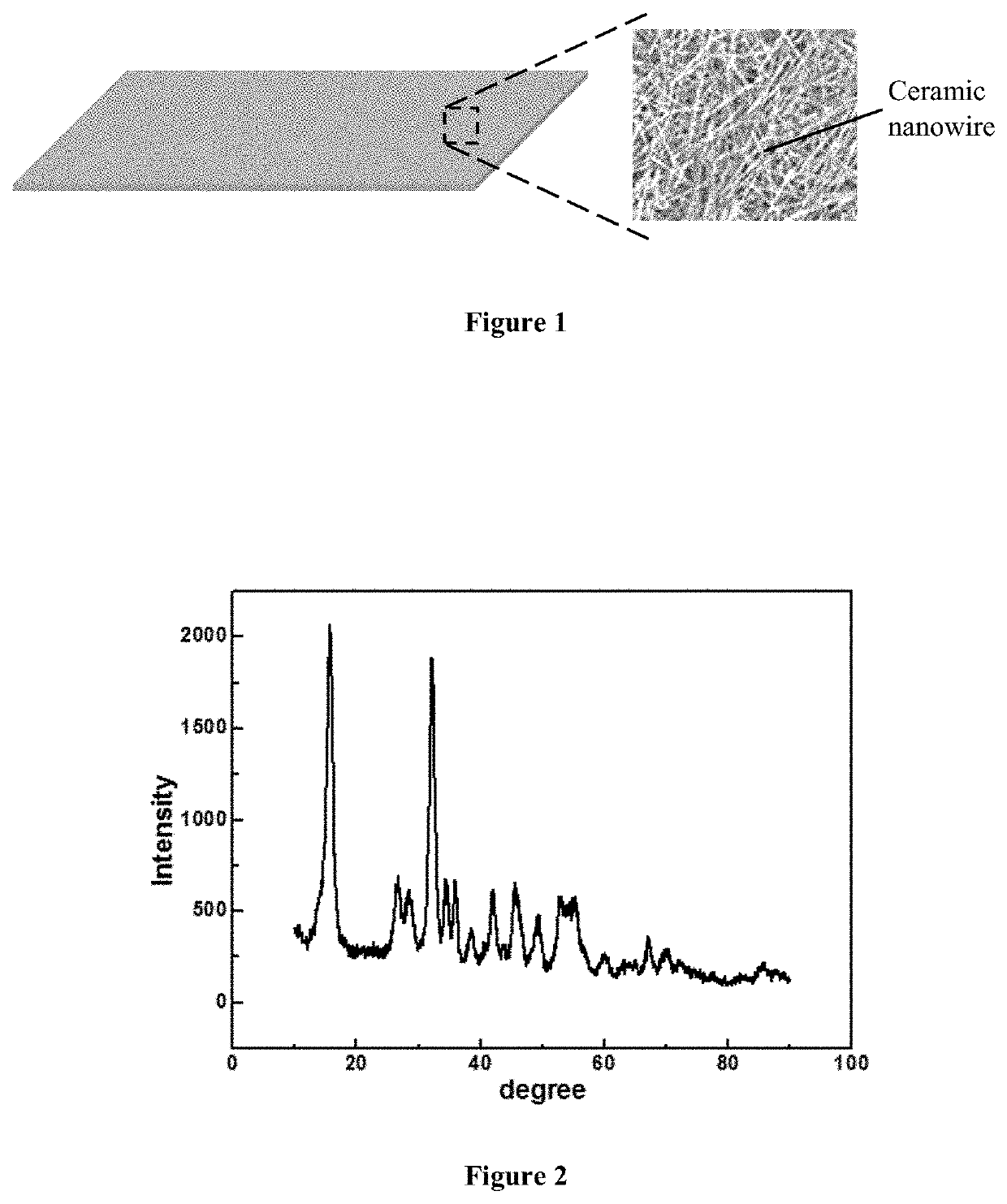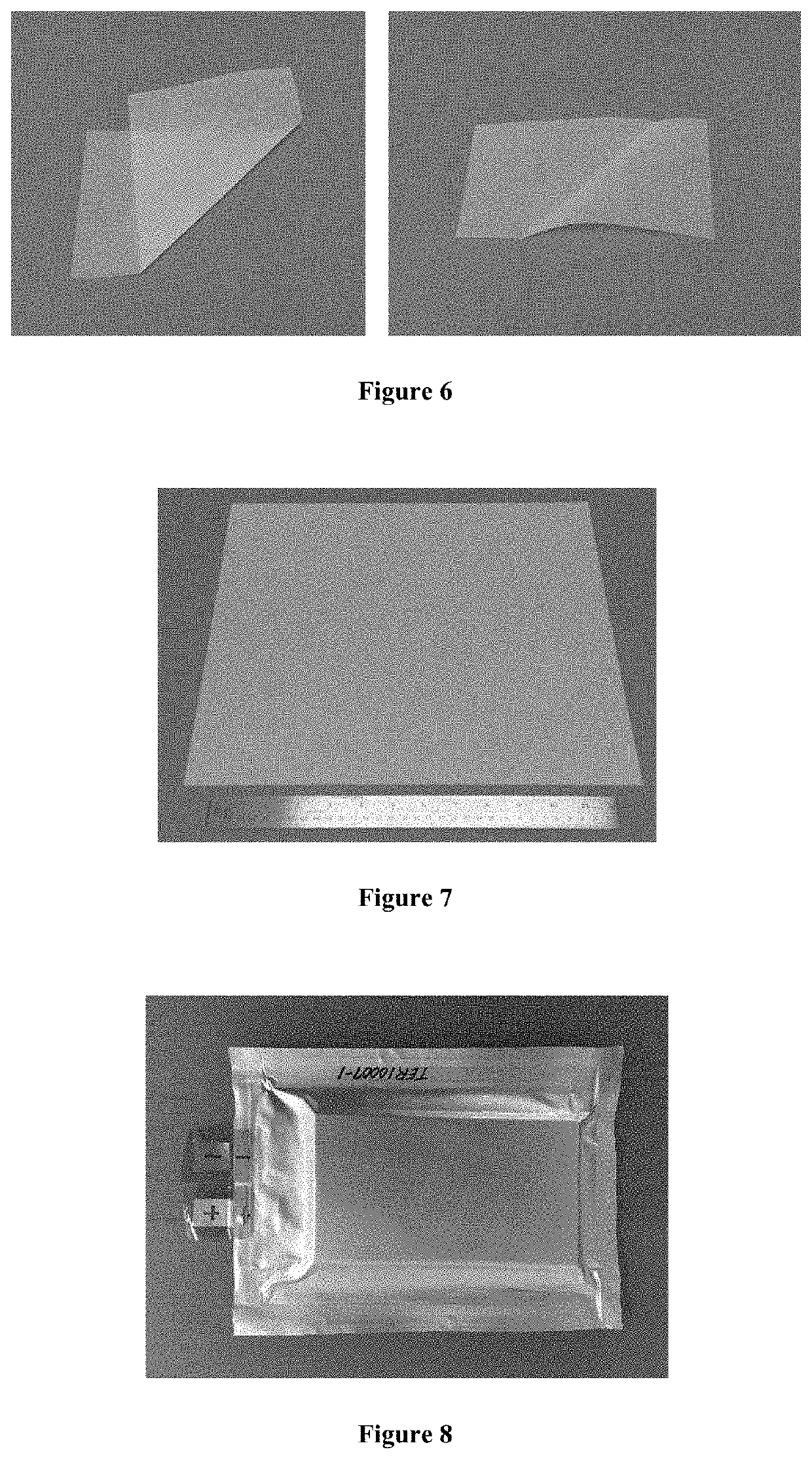Ceramic Nanowire Battery Separators
- Summary
- Abstract
- Description
- Claims
- Application Information
AI Technical Summary
Benefits of technology
Problems solved by technology
Method used
Image
Examples
example 1
The Preparation of Ceramic Nanowires
[0045]140 ml deionized (DI) water, 12.6 g baking soda (Arm & Hammer) and 1.0 g sodium hydroxide (Aldrich, >95%, flakes) were added to a blender jar and were blended to form a solution (Solution A). 40 g aluminum isopropoxide (Alfa Aesar, 98+%) was added to Solution A and was blended to produce a slurry (Slurry B). Slurry B was then transferred into a 500 ml pressure vessel, which was then sealed and heated at 140° C. for 24 hours. Then the pressure vessel was cooled naturally to room temperature, and dihydroxyaluminum sodium carbonate nanowires were obtained. XRD characterization revealed the as-prepared nanowire product has a major crystal phase of dihydroxyaluminum sodium carbonate (major product) with a very small amount of aluminum oxide hydroxide crystal phase, as shown in FIG. 2. The resultant nanowire product was characterized for morphology by using scanning electron microscopy (SEM), as shown in FIG. 3. SEM image indicated that the nanowi...
example 2
The Preparation of Pure Ceramic Nanowire Membranes
[0046]The ceramic nanowires from Example 1 was mixed with DI water in a weight ratio of about 6:1 (water:nanowires). The wax-like nanowire solid was then broken into small chunks by mechanical crushing. A small amount of concentrated hydrogen chloride solution was added to the slurry to adjust its pH to about 7. The neutralized nanowire slurry was then filtered through an UHMWPE membrane (7 to 12 micron pore size) with a vacuum filtration, and washed twice using DI water to form a wet cake. The washed wet cake was mixed with DI water to form a honey-like slurry. The slurry was then processed through an EXAKT 50 three-roll mill three times with the final roller gap of about 30 micron to get a very uniform nanowire slurry with about 7.5% solid nanowires. We name this slurry as the Milled Nanowire Slurry for the convenient use in the following Examples. The Milled Nanowire Slurry was dispersed in basic DI water (prepared by adding 4.4 g...
example 3
The Preparation of Ceramic Nanowire-Cellulose Nanofiber Separator Membranes
[0047]Cellulose nanofibers (Guilin Qihong Technology Co., Ltd.) were dispersed in DI water by a blade blender to form a cellulose nanofiber suspension (˜0.5 wt %). The Milled Nanowire Slurry from Example 2 was then added to the cellulose nanofiber suspension, and the mixture was further dispersed using basic DI water (4.4 g of sodium hydroxide in 2.2 L DI water) to form a mixture suspension, which comprised 0.22 wt % of ceramic nanowires and 0.024 wt % of cellulose nanofibers. 2.2 L of the formed mixture suspension was then poured into a 42 cm×42 cm filtration system and filtered through a porous UHMWPE membrane (7 to 12 micron pore size) under vacuum. The wet ceramic nanowire-cellulose nanofiber membrane was washed by DI water (pH 7) twice and dried at room temperature. The dried ceramic nanowire-cellulose nanofiber membrane was then released from the UHMWPE membrane, resulting in the final freestanding cera...
PUM
| Property | Measurement | Unit |
|---|---|---|
| Length | aaaaa | aaaaa |
| Length | aaaaa | aaaaa |
| Length | aaaaa | aaaaa |
Abstract
Description
Claims
Application Information
 Login to View More
Login to View More - R&D
- Intellectual Property
- Life Sciences
- Materials
- Tech Scout
- Unparalleled Data Quality
- Higher Quality Content
- 60% Fewer Hallucinations
Browse by: Latest US Patents, China's latest patents, Technical Efficacy Thesaurus, Application Domain, Technology Topic, Popular Technical Reports.
© 2025 PatSnap. All rights reserved.Legal|Privacy policy|Modern Slavery Act Transparency Statement|Sitemap|About US| Contact US: help@patsnap.com



